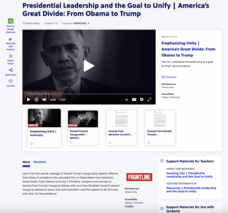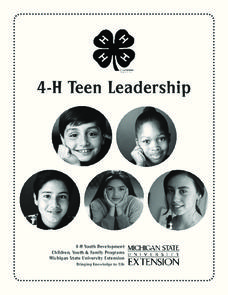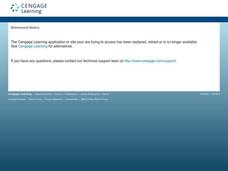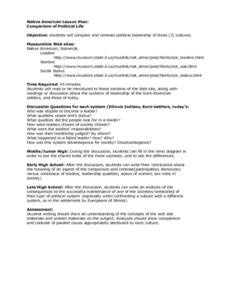Township of Wilmot
Kindergarten: Exploring the Concept of “Leadership”
Kindergartners aren't too little to be leaders! Teach them about the qualities and responsibilities of all types of leaders, including political figures, community leaders, and family members, with an engaging lesson for young...
Curated OER
Women in Texas Politics: Winning the Vote, Three Pioneers, and Serving the People
Fourth graders study women's involvement in Texas politics. In this US history lesson plan, 4th graders discuss woman suffrage, examine three Texas female pioneer legislators by reading biographies, and explore women's issues by...
Museum of the American Revolution
Leadership and Alexander Hamilton
Alexander Hamilton serves as a model in a lesson that asks young political scientists to consider the strengths and weaknesses of six different leadership styles. They read a brief overview of Hamilton's activities before, during, and...
PBS
Lessons in Leadership, Roosevelt Style
It's easy to criticize those in power until you're sitting at their desk, faced with the same decisions. A history lesson prompts secondary learners to research the Roosevelt presidencies through the lens of leadership and...
Curated OER
Leaders & Leadership: A Political Power Structure from Washington to West KY
Though outdated (the presentation names members of the Bush Administration as current political leaders), these slides could be useful to an industrious teacher who is willing to update the information in the Executive, Judicial, and...
PBS
Presidential Leadership and the Goal to Unify | America’s Great Divide: From Obama to Trump
Traditionally, a United States President's Inaugural Address establishes the tone and vision for his presidency. It has stressed the goal to unify the country and bring the political parties together after what are often divisive...
National Endowment for the Humanities
Shakespeare's Julius Caesar: Leadership and a Global Stage
Shakespeare's Julius Caesar is, among other things, the study of a ruler's ambitions. Young scholars watch videos, read articles, and keep a Commonplace Book while studying the play. At the end of Act III, pupils stage the play that...
Michigan State University
4-H Teen Leadership
Take your 4-H teens to the next level! Help them learn how to be an active part of their communities with a teen leadership development unit. Individuals, together with school and community partners, create and execute a service-driven...
Curated OER
The Political Dr. Seuss
Students discuss the role political cartoons have played in U.S. politics and public affairs since the 1700's. They analyze some of the political cartoons Dr. Seuss drew during World War II and discuss how these cartoons conveyed his...
Curated OER
Cartoons for the Classroom: Multinational Corporations
The octopus is a commonly used symbol in political cartoons. Help your scholars examine why it has been used in this way throughout history. Three cartoons depict different uses of the octopus. Background information helps gives context...
Curated OER
Homemade Political Parties
Use this 5-day instructional activity to clarify the platforms of the two major parties, comparing and contrasting against learners' beliefs. Begin by looking at unlabeled summaries of both party platforms, having learners identify most...
Curated OER
Political Cartoons and Dr. Seuss
Pupils study political cartoons by Dr. Seuss. They create their own political cartoons on a current event.
Curated OER
Leadership
Young scholars identify the main types of leadership styles. They research different theories of leadership and discuss. They participate in scenerios using the information they gathered throughout the lesson.
Curated OER
Leadership in Jamestown
Students formulate criteria for leadership based on evaluation of Jamestown's leaders, and identify origins, compositions, and goals of the Virginia Company.
Curated OER
Comparison of Political Life
Pupils research and compare and contrast the political leadership of three cultures.
Curated OER
Politics and Leadership
Students research a historic leader and analyze how a philosopher's writings influenced the ruler in an essay. In this philosophy of government lesson plan, students view a video and participate in a class discussion on how great...
Reading Through History
The Leadership of George Washington
Why did Americans choose George Washington as their first president? After reading the resource, pupils discover why citizens trusted him to lead the country. They learn about his time as a military leader, as well as his actions after...
Curated OER
Cartoons for the Classroom: Symbolism, Octopus
In this current events worksheet, students analyze political cartoons regarding the symbolism of the octopus and respond to 3 talking point questions.
Curated OER
The Emerging Political Spectrum
In this political perspectives activity, students complete a graphic organizer that requires them to put the listed terms, that describe Republicans, Liberals, and Conservatives from 1815-1848, in the appropriate places.
Curated OER
Politics
In this online interactive world history worksheet, students answer 25 matching questions regarding French politics during the Reign of Terror. Students may submit their answers to be scored.
Scholastic
What Makes a Leader?
After creating a list of great American leaders from the last century and researching their lives, pupils will brainstorm aspects of leadership and discuss what traits may be shared by all leaders.
Annenberg Foundation
Student Voices
Whether it's an election year or not, a unit on voting patterns and political campaigns will awaken the civic pride in your high school citizens. Divided into six parts, the curriculum covers various facets of an election, including...
Humanities Texas
Primary Source Worksheet: Text of “Prouder, Stronger, Better"
Political ads as primary source documents? But of course. Viewers analyze the strategies involved in the Republican Party's 1984 advertisement in support of Ronald Reagan's reelection.
Curated OER
Electoral Process and Political Leadership
Students analyze voting issues. In this Bill of Rights lesson, students read articles regarding the election of 1824, government in ancient Rome, and lack of voter participation. Students discuss their impressions of each of...

























